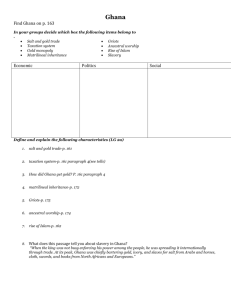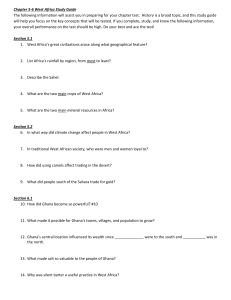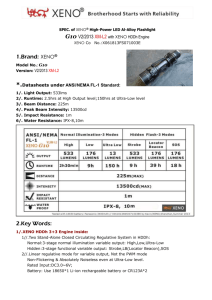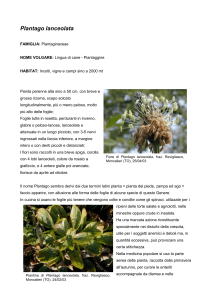Xenoestrogens- Where we find them and what do they create within
advertisement
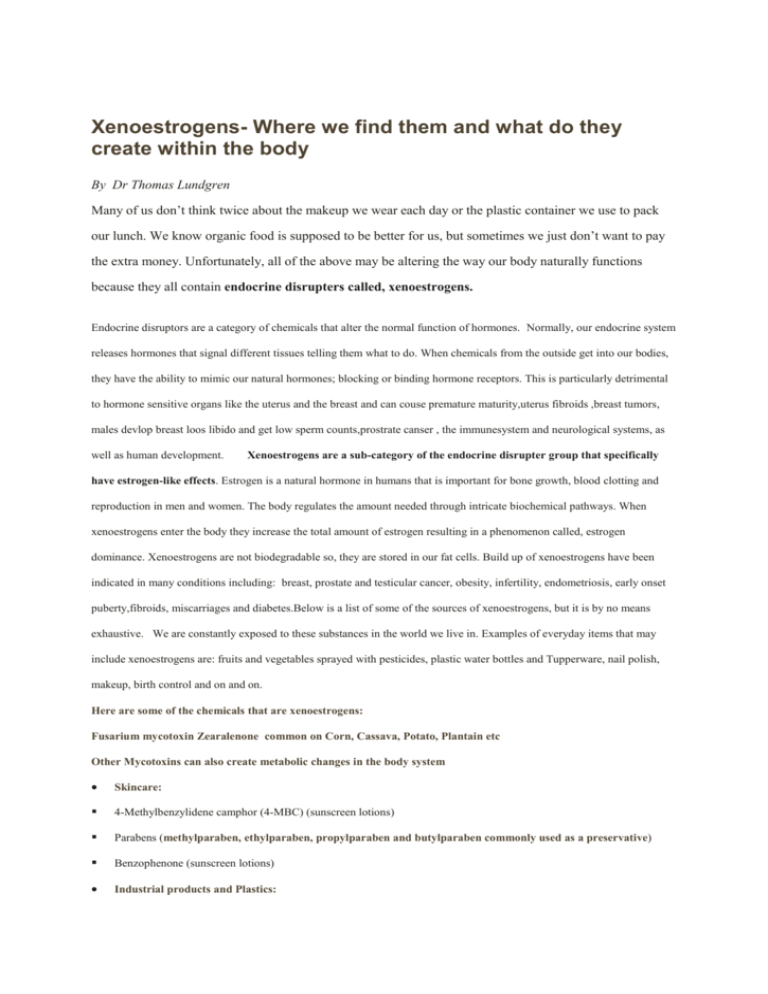
Xenoestrogens- Where we find them and what do they create within the body By Dr Thomas Lundgren Many of us don’t think twice about the makeup we wear each day or the plastic container we use to pack our lunch. We know organic food is supposed to be better for us, but sometimes we just don’t want to pay the extra money. Unfortunately, all of the above may be altering the way our body naturally functions because they all contain endocrine disrupters called, xenoestrogens. Endocrine disruptors are a category of chemicals that alter the normal function of hormones. Normally, our endocrine system releases hormones that signal different tissues telling them what to do. When chemicals from the outside get into our bodies, they have the ability to mimic our natural hormones; blocking or binding hormone receptors. This is particularly detrimental to hormone sensitive organs like the uterus and the breast and can couse premature maturity,uterus fibroids ,breast tumors, males devlop breast loos libido and get low sperm counts,prostrate canser , the immunesystem and neurological systems, as well as human development. Xenoestrogens are a sub-category of the endocrine disrupter group that specifically have estrogen-like effects. Estrogen is a natural hormone in humans that is important for bone growth, blood clotting and reproduction in men and women. The body regulates the amount needed through intricate biochemical pathways. When xenoestrogens enter the body they increase the total amount of estrogen resulting in a phenomenon called, estrogen dominance. Xenoestrogens are not biodegradable so, they are stored in our fat cells. Build up of xenoestrogens have been indicated in many conditions including: breast, prostate and testicular cancer, obesity, infertility, endometriosis, early onset puberty,fibroids, miscarriages and diabetes.Below is a list of some of the sources of xenoestrogens, but it is by no means exhaustive. We are constantly exposed to these substances in the world we live in. Examples of everyday items that may include xenoestrogens are: fruits and vegetables sprayed with pesticides, plastic water bottles and Tupperware, nail polish, makeup, birth control and on and on. Here are some of the chemicals that are xenoestrogens: Fusarium mycotoxin Zearalenone common on Corn, Cassava, Potato, Plantain etc Other Mycotoxins can also create metabolic changes in the body system Skincare: 4-Methylbenzylidene camphor (4-MBC) (sunscreen lotions) Parabens (methylparaben, ethylparaben, propylparaben and butylparaben commonly used as a preservative) Benzophenone (sunscreen lotions) Industrial products and Plastics: Bisphenol A (monomer for polycarbonate plastic and epoxy resin; antioxidant in plasticizers) Phthalates (plasticizers) softners DEHP (plasticizer for PVC) Polybrominated biphenyl ethers (PBDEs) (flame retardants used in plactics, foams, building materials, electronics, furnishings, motor vehicles). Polychlorinated biphenyls (PCBs) Food: Corn,Cassava,Potato, Plantain e.t.c. from Fusarium mould Mycotoxin : Zearalenone Erythrosine / FD&C Red No. 3 Phenosulfothiazine (a red dye) Butylated hydroxyanisole / BHA (food preservative) Building supplies: Pentachlorophenol (general biocide and wood preservative) Polychlorinated biphenyls / PCBs (in electrical oils, lubricants, adhesives, paints) Insecticides: Atrazine (weedkiller) DDT (insecticide, banned) Dichlorodiphenyldichloroethylene (one of the breakdown products of DDT) Dieldrin (insecticide) Endosulfan (insecticide) Heptachlor (insecticide) Lindane / hexachlorocyclohexane (insecticide, used to treat lice and scabies) Methoxychlor (insecticide) Fenthion Nonylphenol and derivatives (industrial surfactants; emulsifiers for emulsion polymerization; laboratory detergents; pesticides) Other: Propyl gallate Chlorine and chlorine by-products Ethinylestradiol (combined oral contraceptive pill) Metalloestrogens (a class of inorganic xenoestrogens) Alkylphenol (surfactant used in cleaning detergents I few questions to the standard control institute in Ghana about xeno oestrogens and other chemicals that can interfere with the human body system functions. 1 : What kind of Mycotoxins can be analysed in Ghana 2: Is there a control of Staple food possible mycotoxins as Aflatoxin, Ochratoxin, Fumonisin, Zearalenone e.t.c. 3: Is there a control of Xeno oestrogens in drinking water plastic materials in Ghana 4: Is there a statistic in Ghana about reproductive problem in the population 5: Is there a control of water quality in Ghana 6: Is there any control of pesticides remains on market ready food as fruite, plantain etc 7: Is there a control of the use of pesticides in Ghana 8: Is there a control of xeno oestrogens in Ghana I’m asking you thise questions as I have realized that the frequenze of reproductive problem is abnormal high in Ghana and it show me signals of a Oestrogen Dominance problem from Xeno oestrogens in the population with Women getting fibroids before age of 25 in Ghana when it is above 40 in developed countries. Males develop breasts and loos libido. Best regards Dr Thomas Lundgren Gmail address : medicalresearchghana@gmail.com Phone nr 0236 84 20 47





